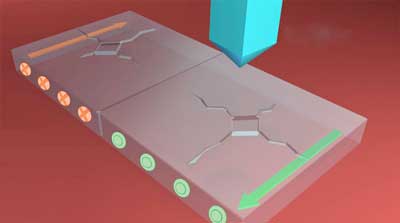| Apr 25, 2019 | |
Crack propagation is asymmetric in polar materials(Nanowerk News) Fracture physics is a central field of study in materials science. In the case of piezoelectric materials, due to their ability to generate strains if subjected to a voltage and vice versa, microcracks are usual and shorten the lifespan of the devices in which they are used. |
|
| Researchers therefore look for ways in which fractures can be prevented, although sometimes they can also be used to our advantage. For instance, controlled cracking has been proposed as a mechanism for device nanopatterning. | |
| Fracture fronts concentrate the maximum deformation that a solid can withstand, so flexoelectricity (polarization induced by deformation gradients) plays a key role. | |
| A recent study published in Physical Review Letters ("Flexoelectric Fracture-Ratchet Effect in Ferroelectrics") shows that crack-generated flexoelectricity acts facilitating or hampering crack propagation, depending on the polarization axis of the material. | |
 |
|
| The team shows how, due to flexoelectricity, cracks in ferroelectrics (switchable polar materials) propagate more easily in the polar direction than in the opposite. (Image: ICN2) | |
| This study has a couple of important implications. It is the first to experimentally demonstrate that crystal fracture is not symmetric: cracks travelling in the polar direction are measurably longer than those traveling against. | |
| Second, since the polarity of a ferroelectric can be switched by voltage, voltage can serve as a tool to manage the propagation of cracks in polar materials, either to mitigate fatigue (the weakening and subsequent breakage of the material), or to promote fracture-based patterning schemes. | |
| The research was led by ICREA Professor and Group Leader Gustau Catalan, from the ICN2 Oxide Nanophysics Group. The first author of the article is Dr Kumara Cordero-Edwards, who is a former member of the Group and nowadays is developing her research at the Université de Genéve (Switzerland). The work counted with the participation of other researchers from the KTH-Royal Institute of Technology (Sweden) and ICREA Prof. Jordi Sort, from the Physics Department at the UAB. |
| Source: ICN2 | |
|
Subscribe to a free copy of one of our daily Nanowerk Newsletter Email Digests with a compilation of all of the day's news. |
